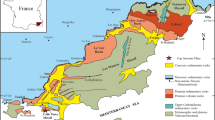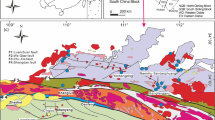Abstract
A complex of lithological-geochemical studies was carried out in rocks of the Upper Jurassic–Lower Cretaceous Bazhenov Formation and their transition zones to host rocks: composition of rocks, ratio of organic carbon and sulfide sulfur (C/S values), and distribution of several redox indicators (degree of pyritization, content of the authigenic uranium, and values of Mn/Al and Mo/Mn ratios). Morphology of pyrite was examined with a scanning electron microscope. Two main types of pyrite were revealed: (a) framboidal pyrite formed during early diagenesis with the participation of bacterial activity; (b) cryptocrystalline pyrite formed during diagenesis (early stage included) and, presumably, mesocatagenesis, i.e., medium substage of catagenesis. It was established that some part of the cryptocrystalline pyrite predated the framboidal variety. Pyritization of rocks with the cryptocrystalline pyrite formation took place at the lower and upper boundaries of the Bazhenov Formation in the over- and underlying rocks, where the low-carbon pyritic rocks are formed. Intense pyritization is also observed in the high-carbon rocks near the top of the Bazhenov Formation, where the pyrite–kerogen rocks are formed. Both low-carbon pyritic and pyrite–kerogen rocks are characterized by C/S < 1.5; rocks of the Bazhenov Formation, by C/S > 2. The low-carbon pyritic and pyrite–kerogen rocks occur near boundaries of the lithologically different members (mainly biogenic rocks in the Bazhenov Formation and terrigenous varieties in the host rocks) that were deposited under different redox conditions existing in the water column and near the marine paleobasin floor. Boundaries of such members could serve as geochemical redox barriers at late stages of lithogenesis. The pyritic and pyrite–kerogen rocks were likely pyritized during diagenesis because of the deposition of pyrite on the geochemical redox barriers from fluids that contained iron sulfides and migrated from the high-carbon Bazhenov sequence. Presumably, pyritization continued during the catagenesis owing to thermogeochemical processes of the organic matter transformation.






Similar content being viewed by others
REFERENCES
Alekseenko, V.A. and Alekseenko, L.P., Geokhimicheskie bar’ery (Geochemical Bariers), Moscow: Logos, 2003.
Berner, R., Sedimentary pyrite formation: an update, Geochem. Cosmochim. Acta, 1984, vol. 47, pp. 605–615.
Berner, R. and Raiswell, R., Burial of organic carbon and pyrite sulfur in sediments over Phanerozoic time: a new theory, Geochem. Cosmochim. Acta, 1983, vol. 47, pp. 855–862.
Bogorodskaya, L.I., Kontorovich, A.E., and Larichev, A.I., Kerogen. Metody izucheniya, geokhimicheskaya interpretatsiya (Kerogen: Study Methods, Interpretation), Novosibirsk: SO RAN, 2005.
Eder, V.G., Zamirailova, A.G., Zanin, Yu.N., and Zhigul’skii, I.A., Characteristics of the lithological composition of main section types in the Bazhenov Formation, Geol. Nefti Gaza, 2015, no. 6, pp. 96–106.
Filina, S.I., Korzh, M.V., and Zonn, M.S., Paleogeografiya i neftenosnost' bazhenovskoi svity Zapadnoi Sibiri (Paleogeography and Oil Potential of the Bazhenov Formation in West Siberia), Moscow: Nauka, 1984.
Gavrilov, Yu.O., Diagenetic Migration of Sulfides in Sediments Accumulated in Different Sedimentation Settings, Lithol. Miner. Resour., 2010, no. 2, pp. 120–135.
Gerasimenko, L.M. and Zavarzin, G.A., Relict cyanobacterial communities, in Problemy doantropogennoi evolyutsii biosfery (Problems in the Pre-Anthropogenic Evolution of Biosphere), Moscow: Nauka, 1993, pp. 222–253.
Gulyaeva, L.A., Sediments in hydrosulfuric basins of the geological past, Dokl. Akad. Nauk SSSR, 1953, vol. 52, no. 5, pp. 1019–1022.
Gurari, F.G. and Matvienko, N.I., Paleogeography of the Bazhenov Formation based on the U distribution therein, in Tr. SNIIGGiMS, Novosibirsk, 1980, no. 275 pp. 81–91.
Hofmann, P., Ricken, W., and Schwark, L., Leythaeuser coupled oceanic effects of climatic cycles from late Albian deep-sea sections of the North Atlantic, in Evolution of the Cretaceous Ocean Climate System, Geol. Soc. Am. Spec. Pap. 332, 1999, pp. 143–160.
Kanipova, Z.A., Michurin, S.V., Gorozhanin, V.M., et al., Isotope-geochemical features of pyrite from oil-bearing rocks of the Ayazov deposit (Bashkirian Ural region), Geologicheskii Sbornik, (Geological Collection), Inst. Geol. Ufim. Nauchn. Tsentra RAN, 2014, no. 11, pp. 169–175.
Kholodov, V.N., Geokhimiya osadochnogo protsessa (Geochemistry of the Sedimentary Process), Moscow: GEOS, 2006, no. 574.
Kholodov, V.N. and Nedumov, R.I., Geochemical criteria of the appearance of hydrosulfuric contamination in waters of ancient basins, Izv. Akad. Nauk SSSR, Ser. Geol., 1991, no. 12, pp. 74–82.
Kontorovich, A.E., Kontorovich, V.A., Ryzhkova, S.V., et al., Paleogeography of the West Siberian sedimentary basin in the Jurassic, Geol. Geofiz., 2013, vol. 54, no. 8, pp. 972–1012.
Kontorovich, A.E., Yan, P.A., Zamirailova, A.G., et al., Classification of rocks of the Bazhenov Formation, Geol. Geofiz., 2016, no. 11, pp. 2034–2043.
Lazar, O.R., Bohacs, K.M., Macquaker, J.H., and Schieber, J., Capturing key attributes of fine grained sedimentary rocks in outcrops, cores and thin-sections: nomenclature and description guidelines, Sediment. Res., 2015, vol. 85, pp. 230–246.
Leventhal, J.S., Carbon-sulfur plots to show diagenetic sulfidation in sediments, Geochem. Cosmochim. Acta, 1995, vol. 59, no. 6, pp. 1207–1211.
Logvinenko, N.V. and Orlova, L.V., Obrazovanie i izmenenie osadochnykh porod na kontinente i v okeane (Formation and Alteration of Sedimentary Rocks in the Continent and Ocean), Leningrad: Nedra, 1987.
Machel, H.G., Krouse, H.R., and Sassen, R., Products and distinguishing criteria of bacterial and thermochemical sulfate reduction, Appl. Geochem., 1995, vol. 10, no. 4, pp. 373–389.
Maclean, L.C., Tyliszczak, T., Gilbert, P.U., et al., A high-resolution chemical and structural study of framboidal pyrite formed within a low temperature bacterial biofilm, Geobiology, 2008, vol. 6, pp. 471–480.
Panchenko, I.V., Nemova, V.D., Smirnova, M.E., et al., Stratification and detailed correlation of the Bazhenov Formation in central West Siberia based on the lithological and paleontological study of cores and GIS, Geol. Nefti Gaza, 2016, no. 6, pp. 22–34.
Perel’man, A.I., Geokhimiya landshafta (Geochemistry of Landscape), Moscow: Geografgiz, 1961.
Perel’man, A.I., Geokhimiya (Geochemistry), Moscow: Vyssh. Shkola, 1989.
Pratt, L.M., Force, E.R., and Pomerol, B., Coupled manganese and carbon-isotopic events in marine carbonates at the Cenomanian-Turonian boundary, J. Sediment. Petrol., 1991, vol. 61, pp. 370–383.
Raiswell, R., Buckley, F., Berner, R.A., and Anderson, T.F., Degree of pyritization of iron as a paleoenvironmental indicator of bottom-water oxygenation, J. Sediment. Petrol., 1988, vol. 58, pp. 812–819.
Reshenie 6-go mezhvedomstvennogo stratigraficheskogo soveshchaniya po rassmotreniyu i prinyatiyu utochnennykh stratigraficheskikh skhem mezozoiskikh otlozhenii Zapadnoi Sibiri (Decisions of the 6th Interdepartmental Stratigraphic Meeting on the Discussion and Acceptance of Refined Stratigraphic Scheme of Mesozoic Rocks in West Siberia), Novosibirsk: SNIIGGiMS, 2004.
Rosen, O.M., Abbyasov, A.A., Migdisov, A.A., and Yaroshevskii, A.A., MINLITH—a program to calculate the normative mineralogy of sedimentary rocks: the reliability of results obtained for deposits of old platforms, Geochem. Int., 2000, no. 4, pp. 388–400.
Savel’eva, O.L., Savel’ev, D.P., and Chubarov, V.M., Pyrite framboids in carbonaceous rocks of the Smagin association in the Kamchatskii Mys Peninsula, Vestn. KRAUNTs. Nauki Zemle, 2013, no. 2 (22), pp. 144–151.
Shurygin, B.S. and Dzyuba, O.S., The Jurassic/Cretaceous boundary in northern Siberia and the Boreal-Tethys correlation of boundary sequences, Geol. Geofiz., 2015, vol. 56, no. 4, pp. 830–844.
Shvanov, V.N., Frolov, V.T., Sergeeva, E.I., et al., Sistematika i klassifikatsii osadochnykh porod i ikh analogov (Systematics and Classification of Sedimentary Rocks and Their Analogs), Leningrad: Nedra, 1988.
Strakhov, N.M., Osnovy teorii litogeneza (Fundamentals of the Theory of Lithogenesis), Moscow: AN SSSR, 1960.
Strakhov, N.M., Problems in geochemistry of modern oceanic lithogenesis, in Trudy GIN AN SSSR, Moscow: Nauka, 1976, no. 292.
Volkov, I.I., Iron sulfides: their interrelation and conversions in Black Sea sediments, in Tr.Inst. Okean. AN SSSR, 1961, vol. 50.
Wignall, P.B., Black Shales, Oxford: Clarendon Press, 1994.
Wignall, P.B. and Myers, K.J., Interpreting the benthic oxygen levels in mudrocks: A new approach, Geology, 1988, vol. 16, pp. 452–455.
Wilkin, R.T., Barnes, H.L., and Brantley, S.L., The size distribution of framboidal pyrite in modern sediments: An indicator of redox conditions, Geochim. Cosmochim. Acta, 1996, vol. 60, no. 20, pp. 3897–3912.
Yurchenko, A.Yu., Takahata, N., Tanaka, K., et al., The Nature of Scattered and Concretion Pyrite in the Upper Abalak Formation of the Salym Oil Field (Western Siberia), Mosc. Univ. Geol. Bull., Ser. Geol., 2016, no. 6, pp. 466–470.
Zakharov, V.A., Formation conditions of the Volgian–Berriasian high-carbon Bazhenov Formation in West Siberia based on the paleontological data, in Evolyutsiya biosfery i bioraznoobraziya (Evolution of Biosphere and Biodiversity), Rozhnov, S.V., Ed., Moscow: KMK Sci. Press Ltd, 2006, pp. 552–568.
Zanin, Yu.N., Eder, V.G., and Zamirailova, A.G., Composition and formation environments of the Upper Jurassic-Lower Cretaceous black shale Bazhenov Formation (the central part of the West Siberian Basin), Mar. Petr. Geol., 2008, vol. 25, pp. 289–306.
Zubkov, M.Yu., Regional and local predictions of oil potential in the Bazhenov and Abalak formations (West Siberia), Gorn. Vedom., 2016, no. 3/4, pp. 46–68.
ACKNOWLEDGEMENTS
The author is grateful to teacher Yu.N. Zanin for many guidance; A.E. Kontorovich for consultations; L.G. Vakulenko, M.A Pavlova, and A.Yu. Yurchenko for useful discussions and valuable remarks during the manuscript preparation; A.G. Zamirailova for lithogeochemical data on the Bazhenov Formation from the Southeastern zone of WSB; E.A. Kostyreva for consultations and participation in the sampling of borehole cores from the North Surgut zone; as well as L.A. Gorchukova, I.M. Fominykh, and N.G. Karmanova (Institute of Geology and Mineralogy, Siberian Branch, Russian Academy of Sciences) and N.V. Aksenova (Trofimuk Institute of Petroleum Geology and Geophysics, Siberian Branch, Russian Academy of Sciences). Special thanks go to V.I. Polyakova for help in the preparation of illustrations.
Author information
Authors and Affiliations
Corresponding author
Additional information
Translated by D. Sakya
Rights and permissions
About this article
Cite this article
Eder, V.G. Pyritization of Rocks in Black Shale/Host Rock Transition Zones: Evidence from the Bazhenov Formation, Western Siberia. Lithol Miner Resour 55, 218–230 (2020). https://doi.org/10.1134/S0024490220030025
Received:
Revised:
Accepted:
Published:
Issue Date:
DOI: https://doi.org/10.1134/S0024490220030025




